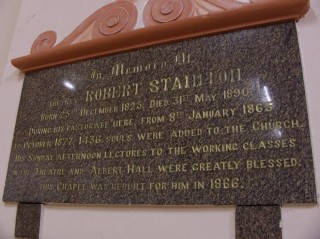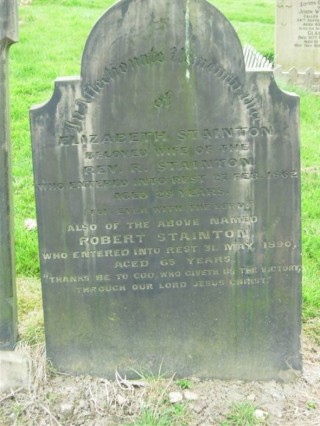Rev. Robert Stainton' s Interment & Funeral Sermon
Sheffield Evening Telegraph & Sheffield Independent, 1890
Researched & Transcribed by Niv Chhabria
Reverend Stainton’ s health deteriorated over the period of 12 years and he sadly passed away on 31st May 1890. At his request his interment took place at Huddersfield.
The transcribed press articles give details about his interment at Huddersfield and the funeral sermon at Garden Street Chapel, Sheffield.
INTERMENT OF THE REV. R. STAINTON
“The interment of the remains the Rev. R. Stainton (formerly pastor of Garden Street Chapel, Sheffield) took place at Huddersfield Cemetery yesterday.
The funeral cortege as it arrived from Willoughby/ Willerby, Hull, was met the station by Mrs. Stainton, Mr. James Stainton, and other relatives of the deceased, also by a number of friends from the Garden Street Chapel, including several the deacons and their wives. The service in the chapel was conducted by the Rev. John Calvert and the Rev. H. J. Boyd, of Sheffield, and at the grave side a brief, earnest address was delivered by Rev. Dr. Bruce, of Huddersfield. There was a large and sympathetic gathering of people to witness the funeral. The interment took place Huddersfield at the express desire of the deceased. Had it taken place in Sheffield there would have been immense concourse people present, judging from the many inquiries made by former friends of the Church. The deceased gentleman has been laid aside by serious mental affliction for nearly 12 years, and it speaks well for his labours in Sheffield that memory is still green among us. He was 65 years of age.
THE LATE REV. R. STAINTON
There was a large congregation on Sunday night, at Garden Street Chapel, when the Rev. H. J. Boyd delivered a funeral sermon in memory of the late Rev. Robert Stainton. The choir, under Mr. W. Sissons, sang as an anthem Dr. Stainer’s “What are these arrayed in white robes,” and the solo, “O, rest in the Lord,” was given by Mrs. Warburton. Mr. Rimmington presided at the organ, and played appropriate voluntaries.
The Rev. H. J. Boyd took for his text, Proverbs x, 7, “The memory of the just is blessed,” and in the course of his sermon gave a review of Mr. Stainton’s career. He was born, he said, in Scotland—a land of religion. The prevailing theology under the influence of which he was brought up was Calvinistic, but as a young man he came under the influence of what was called “The new light” taught by Dr. Morrison and others. He went to hear out of curiosity Mr. (afterwards Dr.) Rutherford, and the impression made on him induced him to see Dr Kirk, a friend and co-worker with Dr. Morrison, and under whose influence he obtained a firm grasp of the truth which he never relaxed. His father, however, was burdened in his soul when he found that he had embraced the Gospel in an Armenian phase, and told him he must either give up his new faith or leave his home. Having to choose, therefore, between his father and Christ, he bade his father farewell, and went out alone into the world. He came to England, and in process of time was found at Liverpool, working with Mr. Ratcliffe, a barrister, who was of like spirit. When working in that city they went together to preach in the streets of Chester during the races, and were taken into custody for obstructing the streets. Afterwards he went to the Lake District, preaching constantly, and was opposed because he preached teetotalism. He, however, hired a barn, and large numbers were attracted to his preaching, a chapel afterwards being erected. Thence he was called to Huddersfield, where he laboured for five years, preaching earnestly in the open-air and at the street corners, and although he did not fill George Street Chapel, doing a great work that was still memorable. Of his work in Sheffield, Mr. Boyd read the following sketch, compiled by Mr. J. M’ Lachlan, from the records of Garden street Chapel:–In this year, 1864, the Rev. R. Stainton, then pastor of George street Chapel, Huddersfield, came to Sheffield to give a temperance lecture, and as his character as an evangelist had preceded him, he was invited to hold a series of revival services in the almost deserted chapel at Garden street. He accepted the invitation, and the services were held for a fortnight, being well attended. Impressions were made upon the congregation which led to personal inquiry, and ended in thorough conversions. It was felt by those who had charge of the place that if the services of Mr. Stainton could be secured the success of the cause would be attained. The Rev. J. Calvert, the Rev. J. P. Gledstone, and other friends guaranteed a certain stipend for the first two years, and an earnest invitation was given to the rev. gentlemen, who at some sacrifice accepted it. He commenced his labours in Garden Street Chapel on January 8th, 1865, preaching to a congregation numbering thirty people. It was a bitterly cold day, and as the chapel was unprovided with heating apparatus, the experience of that day kept some away until warmer weather came. On the 24th February, a church was formed, consisting of thirty-three members, most of whom were volunteers from other churches, some of them sacrificing position and influence in order to help in raising a cause which had been looked upon as dead. But God had sent the right man, for we find that in the ten months following the formation for the church, 102 members had been admitted, many of whom had never been associated with God’s people, and a goodly number of them out of the immediate neighbourhood. At the end of thirteen months it was found that the accommodation in the old chapel was insufficient, and steps were taken to build the present structure, which, with the schools annexed, cost over £3000. In the raising of this large sum, Mr. Stainton did his full share, but whilst all were engaged on the new building affairs, the spiritual part was not neglected, for during the second year 166 members and in the third year 131 were added to the church roll. The churches at this time were agitated by the question, “How to reach the masses.” On this question men had thought and written, but Mr. Stainton, who at first was associated with the Rev. H. Tarrant, practically solved the problem by going to the people who would not come to our churches and chapels. For about nine years during the winter months he had an afternoon service in the Theatre Royal, and it was no unusual thing to find that many could not obtain admission. On this work the blessing of God was plainly visible, for it brought to Garden Street Chapel such crowds that often long before the service commenced every seat was filled, and to those vast gatherings Mr. Stainton told the old old story, with such wonderful effect, that there were added to the church in the fourth year 108; fifth year, 114; sixth year, 120; seventh year, 99; eighth year 84; ninth year, 79; tenth year, 78; making a total in ten years of 1081, or, as it has been said, a soul for every sermon. In 1875 Messrs. Moody and Sankey, the American evangelists, came to Sheffield, and Mr. Stainton heartily entered into the work. The result of that visit was that the town was moved from centre to circumference. It might aptly be said that this was Sheffield’s Pentecostal day. At one service during the year 83 were admitted to membership, and for the whole year the admissions were 216. In the 12th year 79 members were added to the church roll. In the report of this year it is said that the calls from outside places took the pastor often away from Sheffield, but that he believed in accepting these calls he was doing what God wished him to do, and the people at Garden Street fully endorsed that opinion. When it is considered that there was a church of over 900 members, some of whom were continually sick, week night meetings, Sunday services, lectures in the Theatre or the Albert Hall, and temperance addresses in the week, it seems a wonder how all this could be accomplished. Friends of all degrees warned him that such a course of endless labour would break him down, but he would cheerfully reply. “Better wear out than rust out, “ and he went on working with an energy and seal that seemed unabated.” Mr. Stainton was a welcome visitor in every home where he was known. Hundreds of homes were made bright by his actions and words. The poor had in him a friend in need, and often has he acted as a physician to the body whilst he has been pointing the sufferer to the great Physician of the soul. He hated tyranny in either classes or masses, and was as ready to denounce the sins of the peasant as the peer. In the 13th year the admissions to Church membership were 60. In October of that year Mr. Stainton preached in Garden Street for the last time, and there are many who will remember how ill he looked, but that indomitable spirit of his would not allow him to miss a service he could perform. From all places and all classes come loving and sympathetic words to his wife and children and to the Church, but although we had to bow to providence of God we felt a light had been extinguished in Sheffield that to human vision could be ill spared and would not readily be replaced. And now he rests from his labours after a painful and protracted illness. To Mrs. Stainton and his sons, Robert and James, we tender our sincere sympathy along with our prayers that God will bless and prosper them. In a few closing observations the preacher enforced the call to “work while it is day.” It was stated during the service that a memorial tablet to Mr. Stainton is to be placed in Garden Street Chapel.”
References;
– Ms. Jennifer Clark, Australia
– British Newspaper Archives; Sheffield Evening Telegraph, 05 June 1890; Sheffield Independent,10 June 1890











No Comments
Add a comment about this page